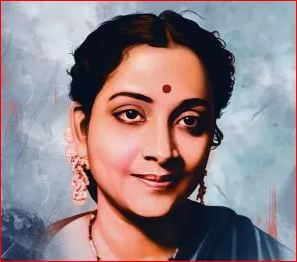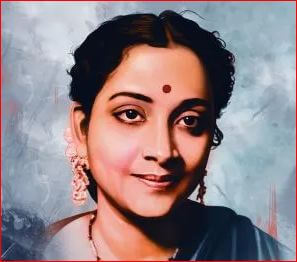Few voices in Indian music history have the same comforting, eerie resonance as Geeta Dutt’s. She mesmerized audiences for centuries with her beautiful voice and unmatched emotional depth, and she still does. Geeta Dutt entered the music industry at an early age, and her skill was immediately apparent. Gifted with a voice that could effortlessly evoke so many different feelings, including joy, longing, and love, she captured listeners’ hearts throughout the country in no time.
Her partnerships with renowned composers like O.P. Nayyar and S.D. Burman produced timeless hits that music lovers still treasure. In addition to her extraordinary singing abilities, Geeta Dutt has contributed more than a thousand songs in several languages to Indian films, each of which embodies her distinct charm and charisma. Her love of music never wavered despite her struggles, and she left a lasting impression on India’s cultural environment.
We go on a voyage through time as we dive into the fascinating world of Geeta Dutt, discovering the tunes that have remained popular with listeners despite time and age. Come celebrate with me the life and legacy of this legendary singer, whose voice is still inspiring new generations of Indian music performers.
Don’t Miss:
- Indian Singer Sadhana Sargam News,Age,Photos & More
- Biography Of Indian Playback And Ghazal Singer Hariharan
Early Life Of Geeta Dutt
Indian classical and playback singer Geeta Dutt was born on November 23, 1930. She became very well-known in Bengali and Hindi movies as a playback vocalist. She performed many contemporary Bengali songs that aren’t related to movies. Geeta Ghosh Roy Chowdhuri was one of ten children born to a wealthy zamindar family in the village of Idilpur, Madaripur Subdivision now under the Gosairhat Upazila of Shariatpur District, Bangladesh.
At the beginning of the 1940s, her family left their land and properties behind and relocated to Calcutta and Assam. Her parents relocated to a Bombay apartment in 1942. When Geeta was twelve, she enrolled in the Bengali High School to complete her education.

Profile Of Geeta Dutt
- Full Name: Geeta Ghosh Roy Chowdhuri
- Date of Birth: 23 November 1930
- Birth Place: Idilpur, Bengal Presidency, British India (present-day Dhaka Division, Bangladesh)
- Nationality: Indian
- Occupation: Singer
- Spouse: Guru Dutt
- Genres: Filmi, Classical, Devotional, Bengali music
- Instruments: Vocals
- Died: 20 July 1972 (aged 41), Bombay, Maharashtra, India
- Years active: 1946–1972
Geeta Dutt’s Personal Life
While recording songs for the film Baazi, Geeta got to know the film’s budding director, Guru Dutt. They tied the knot on May 26, 1953. Three children were born to them together: Tarun, Arun, and Nina. She has recorded other non-film albums, performing songs composed by well-known music directors such as Anal Chatterjee and Sudhin Dasgupta. Guru Dutt premiered the film Gauri in 1957, featuring Geeta Dutt as the lead vocalist. It was supposed to be the first cinemascope film in India.
Only a few days prior, Geeta had started drinking and Guru Dutt had developed a romantic relationship with Waheeda Rehman. Geeta’s singing career was impacted by her marriage ending. Guru Dutt passed away in 1964 as a result of consuming too much alcohol and sleeping medications. This completely broke Geeta, who went on to have a severe nervous breakdown and financial difficulties. She attempted to carry on with her singing career, performing on stage and cutting records at Durgā Pujā.
Geeta Dutt’s Career
Geeta Dutt’s lovely voice became a byword for adaptability, moving from classical to contemporary music with ease. Her partnerships with musical legends like S.D. Burman produced ageless hits that appeal to listeners of all ages. With hits like “Mera Naam Chin Chin Chu” and “Babuji Dheere Chalna,” where her voice captured the essence of every emotion, Dutt’s career took off. Her ability to bring enthusiasm to upbeat songs and sadness to melancholic melodies brought her widespread recognition.
She starred in a Bengali film called Badhu Baran (1967) and sang beautifully in the Kanu Roy-composed Anubhav (1971). Geeta Dutt performed for Midnight in 1972, her last performance (unreleased). A pair of duets, one featuring Talat Mahmood.
Notable Sings
- Kato gaan haralam tomar majhe ‘ (Music : Anal Chatterjee)
- ‘ Krishnachura aagun tumi ‘ (Music : Sudhin Dasgupta)
- ‘ Ektu chaoya, ektu paoya ‘ (Music : Sudhin Dasgupta)
- ‘..Aay aay moynamotir ganye ‘ (Music : Kanu Roy)
- ‘Shachimata Go Char Juge Hai’ (1950)
- ‘Ekhan-O Dustar Lajja’ (1952)
- ‘Ei Sundar Swarnali Sandhyay’
- ‘Katha Achhe Tumi Aj Asbe (Kanu Ghosh 1960)
- ‘Ei Mayabi Tithi’ (Shonar Horin, 1959; Music: Hemant Mukherjee)
- ‘Tumi Je Amar'[13] (Harano Sur, 1958; Music: Hemant Kumar)
- ‘Nishi Raat Banka Chand Aakashe’
- ‘Jhanak Jhanak Kanak Kankan Baaje’
- ‘ Sundar, jano na ki…..’ ( Indrani, 1958; Music : Nachiketa Ghosh)
- ‘ Kancher churir chhata’ ( Dak Harkara; Music : Sudhin Dasgupta)
- “Zara Saamne Aa” (Baaz – 1953)
- “Babuji Dhire Chalna” (Aar Paar – 1954)
- “Thandi Hawa Kali Ghata” (Mr. & Mrs. ’55 – 1955)
- “Jaane Kahan Mera Jigar Gaya Ji” (Mr. & Mrs. ’55 – 1955)
- “Jab Badal Lehraya” (Chhoomantar – 1956)
- “Mere Zindagi Ke Humsafar” (Shrimati 420 – 1956)
- “Jaata Kahan Hai”
- “Chor, Lutere, Daku” (Ustad – 1957)
- “Mera Naam Chin Chin Chu” (Howrah Bridge – 1958)
- “Kaisa Jadoo Balam Tune Dara” (12 O’clock – 1958)
- “Jai Jagadish Hare” Composed By A Sanskrit Poet Jayadeva Circa 1200 AD
- “Na Jao Saiyaan Chhuda Ke Baiyaan” (Sahib Bibi Aur Ghulam – 1962)
- “Kaise Roko Ge Aise Toofan Ko” (Anandmath – 1952 ) With Talat Mahmood
- “Madbhari Hain Pyar Ki Palken” (Fashion – 1957)
- “Na Yeh Chand Ho Ga” (Shart – 1954)
- “Piya Aiso Jiya Mein Samaye Gayo” (Sahib Bibi Aur Ghulam – 1962)
- “Chale Aao Chale Aao” (Sahib Bibi Aur Ghulam – 1962)
- “Aye Dil Mujhe Bata De'”(Bhai Bhai – 1956)
- “Mujhe Jaan Nah Kaho Meri Jaan” (Anubhav – 1971) Music: Kanu Roy
- “Mera Dil Jo Mera Hota” (Anubhav – 1971) Music: Kanu Roy
- “Koi Chupke Se Aake” (Anubhav – 1971) Music: Kanu Roy
- “Mera Sundar Sapna Beet Gaya” (Do Bhai – 1947)[8]
- “Woh Sapne Waali Raat” (Pyaar – 1950)
- “Tadbir Se Bigdi Hui Taqdeer” (Baazi – 1951)
- “Aan Milo Aan Milo” (Devdas – 1955 ) With Manna Dey
- ” Jane kya tune kahi” (Pyaasa – 1957)
- “Hum Aap Ke Aankhon Main” (Pyaasa – 1957) with Mohd. Rafi
- “Hawa Dhire Aana” (Sujata – 1959)
- “Waqt Ne Kiya Kya Haseen Sitam” (Kaagaz Ke Phool – 1959)
- “Janu janu re” (Insaan Jaag Utha) with Asha Bhosle
Upshot
Geeta Dutt’s legacy is still a source of inspiration, demonstrating the strength of ability, tenacity, and artistic development. She carved her place in the history of Indian film and left a lasting impression on the hearts of millions with her enthralling voice and moving performances.
Geeta’s path reminds us that success frequently results from steadfast determination and tireless pursuit of greatness. It also serves as a beacon of hope and resilience. Her ability to move across genres with ease, from upbeat tunes to soul-stirring ghazals, demonstrated her variety and skill.
Dutt’s life serves as an example of how art has the power to change lives by bridging linguistic and cultural divides and impacting people of all ages. Her classic tunes are still in demand among listeners, connecting them to the past & future.
As we consider Geeta Dutt’s incredible career, let’s not only honor her musical brilliance but also find inspiration in her path. Her tale should encourage young people with skills to follow their dreams without fear, believing that everything is possible with hard work and determination. By paying respect to Geeta Dutt, we not only recognize a great artist but also the persistent creative spirit that infuses our lives with meaning and creativity.
FAQs
1. How can I listen to Geeta Dutt’s music more?
A: You can explore Geeta Dutt’s discography through CDs and digital downloads, or you can listen to her tracks on a variety of music streaming services.
2. Which were some of the well-known tunes by Geeta Dutt?
A: With her passionate interpretations of songs like “Mera Naam Chin Chin Chu” from “Howrah Bridge” and “Waqt Ne Kiya Kya Haseen Sitam” from the movie “Kaagaz Ke Phool,” Geeta Dutt captivated viewers. Her versatility allowed her to contribute both lively and romantic songs to Indian music, making a lasting impression.
3. What kind of singing did Geeta Dutt do?
A: Geeta Dutt was known for her easy grace and profound emotional range in her singing. She possessed a special capacity to bring real emotion to every song, enthralling listeners with her emotive voice.
4. What did Geeta Dutt leave behind?
A: Geeta Dutt left behind a legacy of timeless melodies that have charmed ears for generations. One of the most adored playback singers in Bollywood history, her contribution to the heyday of Indian cinema is still unmatched.
